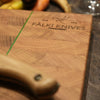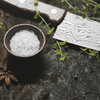The world of wooden handles: A journey through their stories and our passion

I'm happy to be able to take you on a little journey today. Where will your journey take you today? In my blog post I'm devoting myself to the exciting topic of woods and their compositions. There are a variety of fascinating woods that we can use to make our handles. In this post I'd like to introduce you to the stories of these beautiful materials and give you an insight into their fascinating world. So that we don't always talk around the issue so much, let's just get started!
Bog oak: timeless elegance with a sense of history
Bog Oak, also known as bog oak, is a wood of remarkable history and timeless elegance. It comes from oak trees that were submerged in bogs hundreds or even thousands of years ago. These are not just wood; they are relics of a bygone era, protected from decay by the anaerobic state of the bog.
origin and creation
The origin of bog oak is often associated with the Nordic countries such as Ireland, Scotland and Scandinavia. These regions offer optimal conditions for the preservation of wood in wet bogs. The oak trees sink into the bog through natural processes and are covered by sediment over time.
appearance and characteristics
The characteristic dark color of the bog oak is caused by the high tannin content in the bog water. The shiny surface is the result of the long storage and the special preservation process. Each handle made of bog oak is therefore not only a masterpiece of craftsmanship, but also a piece of history that has stood the test of time.
uniqueness and sustainability
The uniqueness of bog oak lies not only in its appearance, but also in its limited availability. Since the extraction of bog oak is laborious and often involves environmental protection measures, each piece becomes a precious commodity. This underlines the sustainability and respect for nature that we uphold at Fàlki Knives.
A knife handle made of bog oak is therefore not only a functional element of our craft, but also a tribute to the past and a statement of appreciation for craftsmanship and the balance of nature. It combines the history of the trees with the skills of the craftsman and thus becomes a unique companion in the kitchen.
Olive Wood: The Golden Soul of the Mediterranean
Olive wood, the "gold of the Mediterranean", comes from the sturdy branches of olive trees, shaped over centuries by sun, wind and culture. The roots of these trees often reach deep into the history of the Mediterranean. Their wood tells not only of centuries-old olive groves, but also of the traditions and ways of life that have flourished in the shade of these trees.
Origin and characteristics:
The main growing areas for olive trees extend over regions such as Greece, Italy, Spain and Turkey. The wood is characterized by a lively grain, which is interspersed with warm, golden tones. The compact structure of the wood creates a natural resistance to moisture, which makes olive wood an ideal companion in the kitchen.
Influence on haptics and aesthetics:
The soft, smooth surface of the olive wood handle is not only beautiful to look at, but also gives the knife a warm, natural feel. Each handle tells the story of the olive tree, its numerous summers and mild winters. With a knife handle made of olive wood, you are not just holding a kitchen tool, but a piece of the Mediterranean way of life in your hands.
Sustainability and respect:
The olive tree is a symbol of survival in dry regions and is often associated with peace and prosperity. When using olive wood, we focus on sustainability by ensuring that only worn branches or trees that are no longer able to bear weight are used to make our handles. This way, the golden soul of the Mediterranean is preserved not only for us, but also for future generations.
A knife handle made of olive wood is therefore not only a masterpiece of craftsmanship, but also a commitment to a way of life that is characterized by respect for nature and a deep understanding of history.
Zebrano: The exoticism of Africa in your hand
Zebrano wood, a fascinating type of wood, takes us on a journey into the wild, tropical forests of Africa. The characteristic zebra-like stripes that give this wood its name are not only a visual highlight, but also carry the stories of sunlight, rain and the untamed life of the African jungle.
Origin and Growth:
Zebrano, also known as Zebrawood, is native mainly to West Africa, particularly the countries of Gabon, Cameroon and Ivory Coast. The stripes are created by the growth of the trees, which adapt to the challenges of the environment. Each stripe tells the story of the years of growth and the vicissitudes of the climate.
Optics and haptics:
The striking grain and the contrasting stripes make zebrano wood a real eye-catcher. The golden brown base color with the dark, almost black stripes gives each handle a unique aesthetic. The feel is particularly pleasant because zebrano wood has a medium to fine texture. Each handle is therefore not only a work of art from nature, but also a tactile experience.
Sustainability and protection:
At Fàlki Knives, we attach great importance to the fact that our zebrano wood comes from sustainable sources. The protection of the tropical forests from which this exotic wood comes is particularly important to us. By using these resources responsibly, we want to ensure that the beauty and uniqueness of zebrano wood is preserved for future generations.
A knife handle made of zebrawood is therefore not only an expression of exoticism and elegance, but also a commitment to responsible action and the preservation of Africa's biological diversity.
Teak: The Queen of Tropical Woods in Your Hands
Teak, the "queen of tropical woods", is not just a wood, but a tribute to the lush tropical forests from whose treasures it springs. The golden brown color and the characteristic grain make teak a jewel of nature that not only looks beautiful, but also has a fascinating story to tell.
Origin and characteristics:
Teak trees are native to Southeast Asia, particularly in countries such as Indonesia, Thailand and Burma. The wood of these trees is characterized by a golden brown base color that fades to a warm honey tone over time. The grain is usually straight, which gives the wood an elegant and uniform structure.
Resistance and durability:
Teak stands for exceptional resistance to weather influences and pests. These properties have made teak a preferred material for building boats and for outdoor use. In the kitchen, a teak handle not only feels pleasant to the touch, but also makes for a solid and long-lasting companion.
Sustainability and protection of tropical forests:
The use of teak at Fàlki Knives goes hand in hand with a clear commitment to sustainability. We use wood from certified plantations that stand for responsible use of natural resources. In this way, we want to ensure that the queen of tropical woods reigns not only today, but also tomorrow and in the future.
A knife handle made of teak combines not only elegance and functionality, but also respect for nature and the heritage of the tropical forests. It is a tribute to the majestic beauty of these woods and at the same time a sign of responsible action in the wood industry.
Rosewood: Exotic elegance for your kitchen
Rosewood, also known as rosewood, is a wood of incomparable beauty and exoticism. Its dark, reddish-brown color and fine grain make rosewood a special choice for knife handles that fascinate not only with their aesthetics but also with their history.
Origin and characteristics:
Rosewood trees are native to the tropical regions of Asia, particularly India and Southeast Asia. The wood of this noble tree is characterized by a striking, dark red to brown color that deepens over time and develops a unique patina. The grain is often fine and even, which gives the wood an elegant structure.
Aesthetics and sensuality:
A rosewood handle is not only beautiful to look at, but also seduces with its sensual feel. The smooth surface and pleasant weight make every cut a sensual experience. The fine grain of the wood tells of the living conditions of the tree, of rain and sun, of heat and humidity.
Rarity and protection:
Rosewood is one of the most precious and rare woods, which underlines its exclusivity. At Fàlki Knives we use rosewood from sustainable sources and are committed to protecting this precious resource. This conscious use of wood is reflected not only in the quality of our knife handles, but also in our responsibility towards nature.
A knife handle made of rosewood is not just a culinary tool, but a work of art from nature and an expression of luxury and exclusivity. It is a statement for the uniqueness of this type of wood and at the same time an appeal for the sustainable use of our natural resources.
Give us your feedback! Which wood appeals to you?
Okay, okay, I can already hear you saying: "So many cool woods, how am I supposed to choose?" Don't worry, we won't overwhelm you - promise! In order not to overwhelm you with all the wood options, we're treating ourselves to a second part of this wood adventure.
But hey, now it's your turn! Which wood caught your attention? The noble bog oak, the sunny olive wood, the wild zebrawood, the robust teak queen or the exclusive rosewood? Or maybe you have a completely different idea of wood in mind?
Your opinion counts! We want to know which wood appeals to you or whether you even have a crazy idea for a wooden handle that will blow us away. The limits are (almost) non-existent - so let your creativity run wild! Your individual preferences are the key to your perfect knife. Write to us what's on your mind and stay tuned for more wood adventures with Fàlki Knives! 🌲🔪






Moin,
ich hab mich beim ersten Messer (Milan in Anthrazitgrau) für Mooreiche entschieden und finde die Kombination edel. Beim 2. Messer habe ich mir Maserbirke bestellt zu dem kleinen Barmesser Gecko. Die Maserbirke ist mir persönlich aber zu hell. Ich habe den Griff dann geräuchert damit er dunkler wird aber man trotzdem noch die Maserung erkennt. Jetzt ist es perfekt für mich.